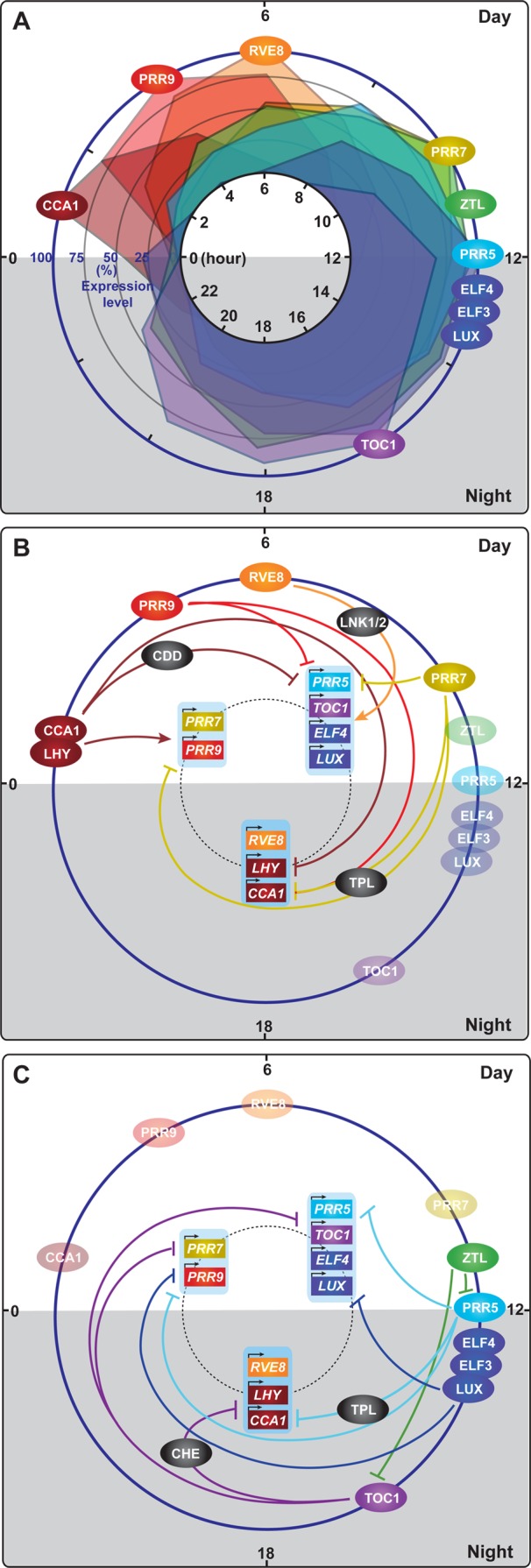Figure 1.

Expression of circadian clock proteins and the architecture of the clock in Arabidopsis thaliana. (A) Daily protein expression profiles of circadian clock components. The expression profiles of the clock proteins are based on the following: CCA1,8 RVE8,32 PRR9,21 PRR7,21ZTL,55 PRR5,21 Evening Complex (ELF4–ELF3–LUX),28 and TOC1.57 The peak expression levels of these proteins were set to 100%, and the rest of the expression levels were calculated against the peak levels. The levels of expression are plotted at 2 h intervals throughout the day. (B) Molecular events occurring from morning to afternoon in the circadian clock. The interactions of clock components and their transcriptional targets, which mainly happen from morning to afternoon, are depicted. In the morning, CIRCADIAN CLOCK ASSOCIATED 1 (CCA1) and LATE ELONGATED HYPOCOTYL (LHY) activate the expression of PSEUDO-RESPONSE REGULATOR 9 (PRR9) and PRR7 and suppress the expression of most evening phase genes such as PRR5, TIMING OF CAB EXPRESSION 1 (TOC1), LUX ARRHYTHMO (LUX), and EARLY FLOWERING 4 (ELF4). CCA1 and LHY form a repressor complex with the CONSTITUTIVE PHOTOMORPHOGENIC 10 (COP10)–DE-ETIOLATED 1 (DET1)–DAMAGED DNA BINDING 1 (DDB1) complex (CDD) to suppress the expression of the evening genes. CCA1 and LHY also suppress their own expression. In the early afternoon, PRR9 and PRR7 suppress the expression of CCA1 and LHY using TOPLESS (TPL) as a corepressor. Downregulation of CCA1 and LHY expression results in derepression of evening phase genes. RVE8, together with NIGHT LIGHT-INDUCIBLE AND CLOCK-REGULATED GENES 1 and 2 (LNK1/2) as coactivators, directly activates expression of evening phase genes, such as PRR5, TOC1, ELF4, and LUX. (C) Molecular events occurring from evening to night in the circadian clock. The interactions of clock components and their transcriptional targets, which mainly happen from evening to the end of the night, are depicted. PRR5 protein continuously suppresses the expression of CCA1 and LHY. PRR5 also represses its own expression. TOC1 suppresses the expression of CCA1 and LHY by itself or interacting with CCA1 HIKING EXPEDITION (CHE). TOC1 also suppresses the expression of other clock components, PRR9, PRR7, TOC1, GI, LUX, and ELF4. ZTL interacts with PRR5 and TOC1 to degrade them in the dark. The Evening Complex (ELF4–ELF3–LUX) suppresses the expression of PRR9 to complete the cycle by induction of CCA1 and LHY. The positions of the circles in panels B and C indicate the timing of peak protein accumulation (based on panel A) of each component.
